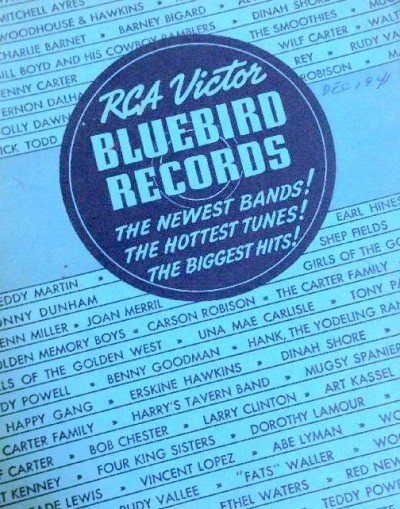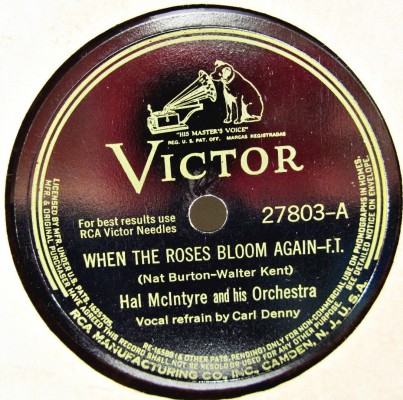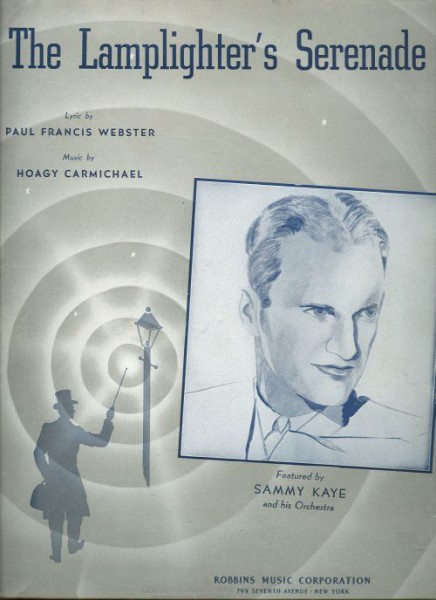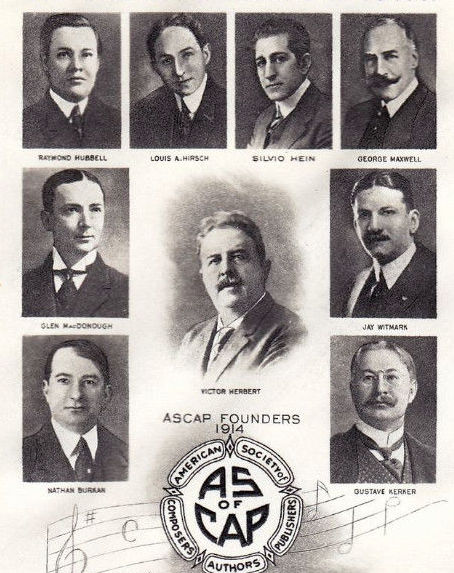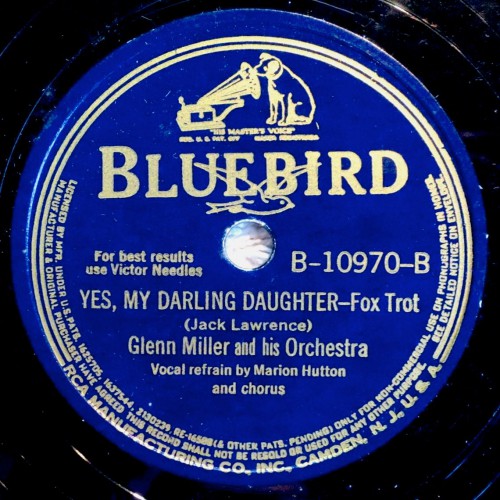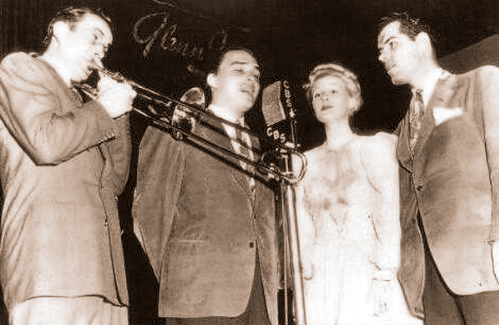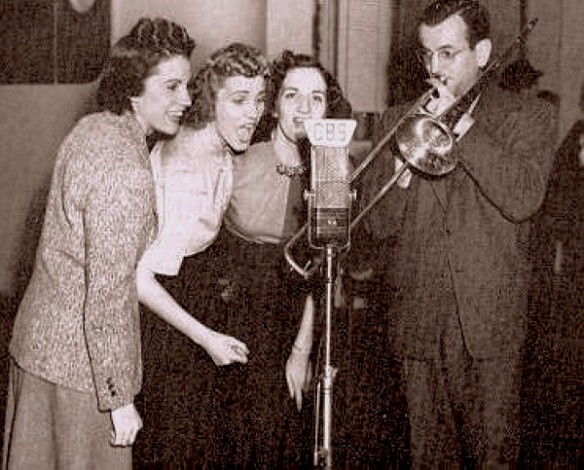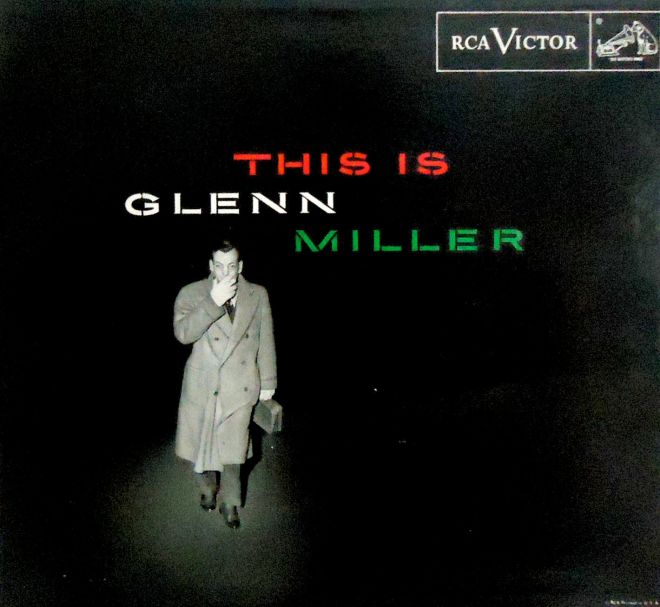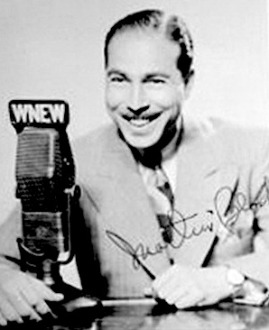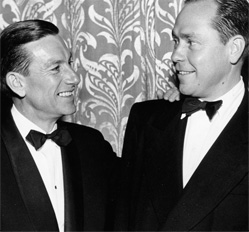Mickey McMickle, Johnny Best, Bill Graham, Billy May (tp); Glenn Miller, Paul Tanner, Jimmy Priddy, Frank D’Annolfo (tb); Skip Martin, Wilbur Schwartz, Ernie Caceres, Tex Beneke, Al Klink (reeds); Chummy MacGregor (p); Bobby Hackett (g & cornet); Doc Goldberg (b); Maurice Purtill (d); Marion Hutton, Ray Eberle, Tex Beneke, The Modernaires (vcl); Bill Finegan, Jerry Gray, Billy May (arr).
RCA Victor Studios, New York – February 18, 1942, 10:00 AM-4:00 PM
071860-1 Shhh, It’s a Military Secret (MH, TB & M vcl, JG arr) Bluebird 11493-B
071861-1 Don’t Sit Under the Apple Tree (MH, TB & M vcl) Bluebird 11474-B
071862-1 She’ll Always Remember (RE & M vcl) Bluebird 11493-A
071863-1 The Lamplighter’s Serenade (RE & M vcl) Bluebird 11474-A
071864-1 When Johnny Comes Marching Home (TB, MH & M vcl, BF arr) Bluebird 11480-B
After a record-breaking run through the Midwest, in January 1942, the Glenn Miller band hit the Paramount Theater in New York for three monumental weeks of packed houses and high grosses. They finished the engagement on February 17th and showed up at RCA Victor the following morning for a solidly commercial and artistically successful recording session. This would be Glenn’s last appearance on 35-cent Bluebird discs. For their next date in April, the band would be raised to the full-price, 50-cent RCA Victor parent label. It made good sense, both promotion-wise and money-wise.
When Miller signed with Victor in 1939, he was placed on Bluebird for several reasons. First, with the Depression still lingering, the lower Bluebird price would likely be more attractive to buyers. Also, as a relatively new band, they didn’t yet have the fan base to warrant a premium price. Finally, RCA Victor wouldn’t dare place a rival trombonist up against hit-maker Tommy Dorsey on the more prestigious label. Clarinetist Artie Shaw found himself in much the same position on Bluebird, so as not to compete with rival Benny Goodman on Victor. Benny moved over to Columbia in August 1939 and so Artie, by now a big disc seller, was bumped up to Victor early in 1940.
Tommy Dorsey wasn’t going anywhere, so RCA waited several more years before promoting Glenn to Victor status. By 1942, the budget labels were less necessary, since record purchasers were making more money as the economy picked up steam. Columbia had experimentally switched Benny to their 35-cent Okeh label in September 1941, in part to compete with Glenn’s similarly-priced platters. Once Glenn transferred to Victor, Benny was immediately restored to 50-cent Columbia status. It was also becoming ridiculous to see Miller alumnus Hal McIntyre’s new band debuting on Victor, while his former leader was still on Bluebird, even recording some of the same songs!
For this February session, once again, the war played heavily into the music selection, as four of the five songs dealt with wartime themes. SHHH, IT’S A MILITARY SECRET was written by black composer Walter Bishop, better known for such jive songs as THE STUFF IS HERE AND IT’S MELLOW and SWING, BROTHER, SWING. Presumably, Earl Allvine wrote the lyrics, as the other name on the song is disc jockey Alan Courtney, who had earlier wangled his name onto Les Brown’s hit number, JOLTIN’ JOE DiMAGGIO.
Like ON THE OLD ASSEMBLY LINE, the song is purely a propaganda poster set to rhythm, with an awkward attempt to leaven the hard-sell (“These are critical times, be careful of espionage”) with romance (“It’s no military secret that I love you”). Yet the band and singers deliver the goods in such a jaunty manner that the results are more delightful than didactic.
Marion, Tex and the Modernaires reappear on DON’T SIT UNDER THE APPLE TREE, another massive Miller hit, free of the cumbersome sloganeering of the previous number. This time, it’s all romance, with an overseas soldier cautioning his girl back home to remain faithful. Unlike the scheming miss of DEAR ARABELLA, this Army sweetheart promises to be true to her worried G.I. Marion gets a full solo chorus to declare her love, showing how much her vocal style had improved by this time. The bouncy arrangement, likely by Jerry Gray, helped to make this disc one of Glenn’s 1942 best.
It was also a hit for the Andrews Sisters, who sang it with Harry James in their popular film, Private Buckaroo. The song was written by veteran hitmakers Lew Brown, Charlie Tobias and Sam Stept. All three began composing in the 1920s and got a new lease on popularity with such timely WWII songs as WE DID IT BEFORE AND WE CAN DO IT AGAIN and THIS IS WORTH FIGHTING FOR.
Next comes SHE’LL ALWAYS REMEMBER, a hefty slice of sentiment mixed with mother love. Like DEAR MOM, this one goes almost over the edge into bathos, with lyrics like, “Now a soldier man you may be, but you are still her baby.” The utterly sincere vocal performance saves it, though. Writers Eddie Pola and Johnny Marks (Mr. RUDOLPH THE RED-NOSED REINDEER) had a minor hit with this song, mostly due to the Miller and Kate Smith recordings. Kate also introduced it on radio, a fact proudly trumpeted on the sheet music cover.
A lovely, dynamic band intro (beautifully recorded, as this whole session happens to be) leads into a sweet Mickey McMickle muted trumpet lead, with the Modernaires humming in the background. Beneke surfaces briefly on tenor and then Ray and the Mods take over for the rest of the disc.
Ray and the Mods also deliver THE LAMPLIGHTER’S SERENADE, another gorgeous Hoagy Carmichael melody, with lyrics by Paul Francis Webster. A memorable touch here are the vocal “doo-wah, doo-wah” phrases by the Modernaires echoing the band’s trumpet “boo-wahs.” Issued as the “A” side of DON’T SIT UNDER THE APPLE TREE, the disc was a double-headed hit. The sweetly nostalgic lyric describes an “old-fashioned gent” who lights street lamps (were there still gas lamps anywhere in 1942?) and casts a love spell on couples passing by. Wonder if he’s a relative of PAPA NICCOLINI?
Glenn’s record was the most successful, though it was also recorded by Bing Crosby and Frank Sinatra, who thought enough of the tune to include it on his first-ever solo session, coincidentally on Glenn’s Bluebird label.
A number of World War I-era songs like OVER THERE and OH, HOW I HATE TO GET UP IN THE MORNING were successfully dusted off and recycled for the new war. Only Glenn thought to reach even further back to the Civil War for WHEN JOHNNY COMES MARCHING HOME. It’s surprising that no other bands picked up on the tune.
This authentic piece of 1863 nostalgia by bandleader Patrick Gilmore was still familiar to 1942 audiences. Modernaires Hal Dickinson and Bill Conway slightly revised the lyric and Bill Finegan shaped and arranged the vintage march into a totally contemporary swing opus. This new version was published by Miller’s Mutual Music firm, making everyone happy.
Finegan really outdid himself, with a witty, extroverted chart full of joyful abandon. The deceptively pianissimo intro and first chorus lead into a stentorian brass passage and then the swinging vocal. Another martial trumpet fanfare culminates in a booting tenor spot for Al Klink and the inevitable jivey rideout. It’s another underrated Miller disc and a great ending to a very enjoyable studio session.
Glenn gave the band a few days off before beginning another road trip down the East Coast, finally heading west to Chicago and then on to Los Angeles. Arriving there on March 17th, they had only a few days to get used to the climate before reporting to 20th Century Fox once again for their second feature film. One more record date would be wedged in before it was time to smile for the cameras.


